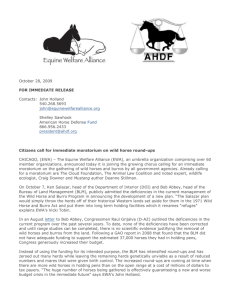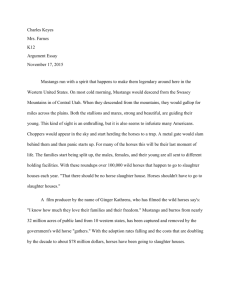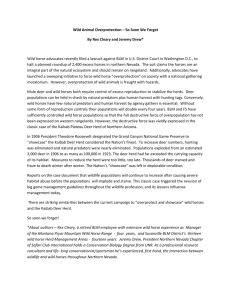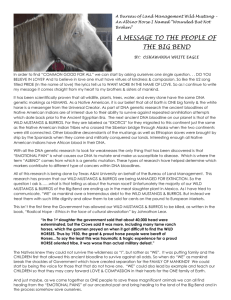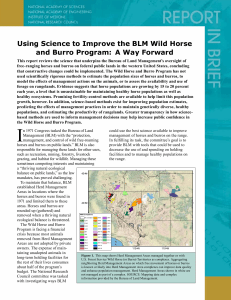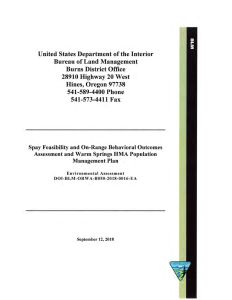Bureau of Land Management and Forest Service Management of
advertisement
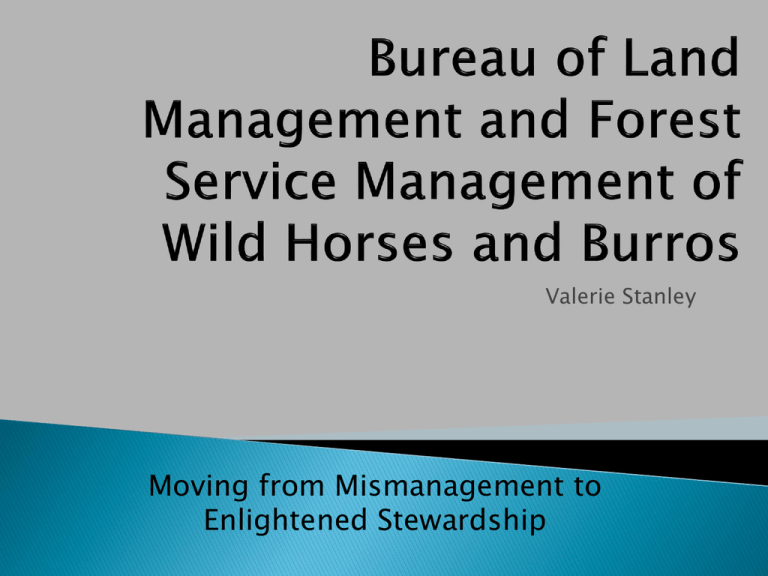
Valerie Stanley Moving from Mismanagement to Enlightened Stewardship Judge Collyer: “How does BLM manage wild horses?” DOJ attorney: “BLM manages them by removing them [from the public lands]” Hearing on Motions for Summary Judgment in Colorado Wild Horse and Burro Coalition v. Kempthorne, Civil Action 06-1609 (D.D.C.), January 13, 2009 Wild Horses and burros are referred to as: a “management problem” Wild horses and burros are criticized because they are free-roaming and not containable in pastures as livestock This is their nature and provided for in the Wild Free-Roaming Horses and Burros Act Land Use Plans or Herd Management Area plans for a given area Establishment of “AML,” i.e. Appropriate (misnomer) Management Level Agreement with Private Groups (such as Rock Springs Grazing Association in Wyoming) Decisions to Remove Wild Horses are not made in Environmental Assessments (“beyond the scope”) Cited 20% annual growth rate (not based on actual knowledge but routinely cited) Placement in Short term holding Placement in Long term holding Adoption Sale without Reservation BLM and FS have been given ample opportunity to change their approaches. While we explore replacements for them, and we explore new strategies, the tough truth is that we will have to keep doing what we have been doing. The requirement that there be “final agency action,” i.e. discreet agency action, is an impediment. The Supreme Court has held that you can’t bring a suit to challenge the entire program of an agency. Due to separation of powers concerns, courts do not sit as overseers of agency programs. There is hope, however. Courts do review agency action, i.e. roundups and treatment of wild horses and burros on a case by case basis. BLM and FS are just like any other agencies whose treatment of animals can be challenged, reviewed, and set aside. With each case brought: ◦ A body of law is developed to assist courts down the road in deciding which decisions to remove wild horses from the public lands are “arbitrary and capricious” and which are supportable. ◦ This body of law familiarizes courts with the Wild Horses Act and surrounding issues and makes them more comfortable reviewing and setting aside decisions to remove wild horses. Courts often have to be presented with an argument five or more times until they see its reasoning, adopt it and make it their own. Continue to comment on land use plans and herd management area plans; File Freedom of Information requests to monitor handling of horses post removal “Adopt a herd” – regularly visit a herd, learn what land/water/development issues impact the herd/follow treatment of the herd, consult experts to develop alternatives to removal Remove wild horse and burro specialists and field managers who consider these animals to be management “problems” or view them as non-native wildlife. Replace them with persons knowledgeable about wild horse behavior and needs. Require wild horse and burro specialists and field managers to actually observe, study and know wild horse family bands and members, seasons of use of herd areas, migratory patterns. Require annual accounts of births and deaths. Require removals to be the option of last resort. Adhere to standards of equine care that caring horse owners provide: • No strenuous exercise when temperature/ humidity can cause suffering • Provision of anesthesia/analgesics before, during and after gelding • No early weaning/separation of dams and foals • No forced strenuous exercise of foals, weanlings and yearlings • If removed, provide horses with permanent access to water and hay that is most similar to current diet

